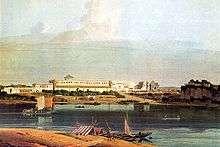Shuja-ud-Daula
Shuja-ud-Daulah (b. 19 January 1732 – d. 26 January 1775) was the Grand Vizier, Subedar[1] and Nawab of Oudh from 5 October 1754 to 26 January 1775.[2]
Shuja-ud-Daulah | |
|---|---|
| Nawab Wazir of Oudh Nawab Wazir al-Mamalik Wazir ul-Hindustan Subedar of Kashmir, Agra & Oudh Khan Bahadur Asad Jang Arsh Manzil | |
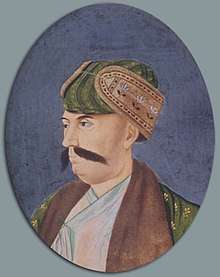 | |
| 3rd Subedar Nawab of Oudh | |
| Reign | 1754 – 26 January 1775 |
| Predecessor | Safdar Jang |
| Successor | Asaf-ud-Daulah |
| Full name
Jalal-ud-din Haider Abul Mansur Khan Shuja-ud-Daulah | |
| Native name | شجاع الدولہ |
| Born | 19 January 1732 Mansion of Dara Shikoh, Delhi, Mughal Empire |
| Died | 26 January 1775 (aged 43) Faizabad, Oudh State (present-day Uttar Pradesh, India) |
| Buried | Gulab Bari, Faizabad |
| Noble family | Nishapuri Branch of the Kara Koyunlu |
| Spouse(s) | Begum Unmatuzzohra Bano "Bahu Begum" |
| Issue | |
| Father | Safdar Jang |
| Mother | Sadh-ruh-nissa |
| Religion | Shia Islam |
| Military career | |
| Allegiance | |
| Service/ | Nawab of Oudh |
| Rank | Grand Vizier, Subadar, Nawab |
| Battles/wars | Mughal-Maratha Wars Third Battle of Panipat Bengal War Battle of Buxar |
Early life
Shuja-ud-Daulah was the son of the Mughal Grand Vizier Safdarjung chosen by Ahmad Shah Bahadur. Unlike his father Shuja-ud-Daulah was known from an early age for his abilities to synthesize his subordinates, this skill would eventually cause him to emerge as the chosen Grand Vizier by Shah Alam II.
Shuja-ud-Daulah was a giant man. Nearly seven feet tall, with oiled moustaches that projected from his face like a pair of outstretched eagle's wings, he was a man of immense physical strength. By 1763, he was past his prime, but still reputedly strong enough to cut off the head of a buffalo with a single swing of his sword, or lift up two of his officers, one in each hand.[3][4]
Shuja-ud-Daulah is also known to have assisted the famous Alivardi Khan on various occasions when the territories of the Nawab of Bengal, were being ravaged by Raghoji I Bhonsle and his Marathas. Thus Shuja-ud-Daulah is known to have been a very respected figure among the servicemen of Alivardi Khan.
Nawab of Awadh
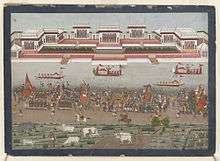
After the death of his father the Mughal Grand Vizier Safdarjung in the year 1753, Shuja-ud-Daula was recognized as the next Nawab by the Mughal Emperor Ahmad Shah Bahadur.
Shuja-ud-Daula despised Imad-ul-Mulk, an ally of the Marathas of the Maratha Empire whose regime emerged after the Battle of Sikandarabad with the support of the Sadashivrao Bhau. Imad-ul-Mulk blinded Ahmad Shah Bahadur and placed Alamgir II on the Mughal imperial throne. Alamgir II and his son Prince Ali Gauhar, were often persecuted by Imad-ul-Mulk because they refused to abandon their peaceful terms with Ahmad Shah Durrani, they also demanded the resignation of Imad-ul-Mulk mainly due to his relations with the Marathas.[5]
Grand Vizier of the Mughal Empire
Prince Ali Gauhar fled from Delhi when he realized a conspiracy that would eventually lead to the murder of the Mughal Emperor Alamgir II. Shuj-ud-Daula welcomed and protected Prince Ali Gauhar, who then declared himself Shah Alam II and officially recognized Shuja-ud-Daulah as the Grand Vizier of the Mughal Empire. Together they challenged the usurper Shah Jahan III, who was placed on the Mughal imperial throne by Sadashivrao Bhau and his forces, which plundered much of the Mughal Empire.
Shah Alam II was then advised to lead an expedition that would attempt to retake the eastern regions of the Mughal Empire from Mir Jafar who was supported by the British East India Company. While Shuja-ud-Daula, Najib-ul-Daula and Mirza Jawan Bakht allied themselves with Ahmad Shah Durrani and assisted his forces during the Second Battle of Sikandarabad in the year 1760 and later led a Mughal Army of 43,000 during the Third Battle of Panipat.[6]
Third Battle of Panipat
After escaping from Delhi due to the murder of his father the Mughal Emperor Alamgir II, the young Prince Ali Gauhar was well received by Shuja-ud-Daula. The Nawab of Awadh and the newly appointed Mughal Grand Vizier Shuja-ud-Daula assured Prince Ali Gauhar that he and Najib-ud-Daula would initiate a struggle that would overthrow the Maratha if Prince Ali Gauhar would lead what remained of the Mughal Army against the expanding British East India Company in Bengal.[7]
Shuja's decision about whom to join as an ally in the Third Battle of Panipat was one of the decisive factors that determined the outcome of the war as lack of food due to the Afghans cutting the supply lines of Marathas was one of the reasons that Marathas could not sustain the day-long battle. Their forces were weak due to starvation and also fighting facing the sun.
Shuja was earlier not very sure about whose side should he take before the Third Battle of Panipat. Marathas were still further south then and it would have taken them considerable time to reach Shuja's province. In spite of His mother was of the opinion that he should join the Marathas as they had helped his father previously on numerous occasions he Joined Abdali.
As the chosen Grand Vizier of the Mughal Empire, Shuja-ud-Daula commanded a sizeable army of Mughal troopers, who cut off the supplies of the Marathas and even defeated them in pitched confrontations during the Third Battle of Panipat and dispatched the Maratha leader Sadashivrao Bhau.
Battle of Buxar
Shuja is also known for his role in the Battle of Buxar, a battle that was no less definite in Indian history. He along with the forces of Mughal emperor Shah Alam II & Mir Qasim ruler of Bengal were defeated by the British forces in one of the key battles in the history of British East India company.
Allahabad Treaty
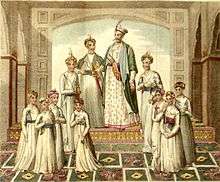
He again fought British with the help of Marathas at Kara Jahanabad and was defeated. On 16 August 1765 AD he signed the Treaty of Allahabad, which said that Kora and Allahabad district will go to Company and the Company will get 5 million rupees from Awadh.[8] British will be allowed free trade in Awadh and will help each other in case of war with other powers, which was a very shrewd politics of the Company.[9]
To pay for the protection of British forces and assistance in war, Awadh gave up first the fort of Chunar, then districts of Benaras, Ghazipur and finally Allahabad.[10]
Reemergence of Shah Alam II

After the defeat in the Battle of Buxar Shah Alam II realised that he needed the help of the East India Company to retain his throne with respect rather than becoming a puppet emperor dominated by Maratha's and he did so.
Death and burial
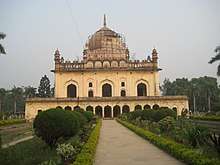
Shuja-ud-Daula died on 26 January 1775 in Faizabad, the then capital of Awadh, and is buried in the same city. His burial place is a tomb and known as Gulab Bari (Rose Garden).
In popular culture
- In the 1994 Hindi TV series The Great Maratha, Shuja's character was portrayed by Benjamin Gilani.
References
- Bhatia, O. P. Singh (1968). History of India, from 1707 to 1856. Surjeet Book Depot.
- Princely States of India
- Dalrymple, William (2019). The Anarchy. United Kingdom: Bloomsbury Publishing. ISBN 978-1-5266-1850-4.
- Journal of the Asiatic Society of Bengal. Bishop's College Press. 1879.
- Srivastava, Ashirbadi Lal (1945). Shuja-ud-daulah. S.N. Sarkar. Retrieved 2 August 2020.
- Mohan, Surendra (1997). Awadh Under the Nawabs: Politics, Culture, and Communal Relations, 1722-1856. Manohar Publishers & Distributors. ISBN 978-81-7304-203-4.
- Cotton, James Sutherland; Burn, Sir Richard; Meyer, Sir William Stevenson (1908). Imperial Gazetteer of India: Provincial Series. Superintendent of Government Printing.
Shah Alam ii an shuja-ud-daula.
- Wikisource: Text of Allahabad Treaty
- HISTORY OF AWADH (Oudh) a princely State of India by Hameed Akhtar Siddiqui
- Shuja-ud-daula (1754–1775)
Further reading
- Shuja-ud-Daulah – Vol. I, II (1754–1765) by Ashirbadi Lal Srivastava
External links
| Preceded by Abu´l Mansur Mohammad Moqim Khan |
Subadar Nawab of Oudh 1754–1762 |
Succeeded by post abolished |
| Preceded by new creation |
Nawab Wazir al-Mamalik of Oudh 1762–1775 |
Succeeded by Asaf ad-Dowla Amani |
